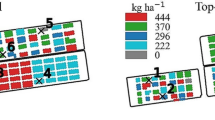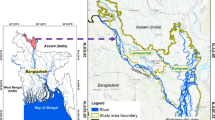Abstract
This study examines the variations of climate variables and rice yield and quantifies the relationships among them using multiple linear regression, principal component analysis, and support vector machine (SVM) analysis in southwest Nigeria. The climate and yield data used was for a period of 36 years between 1980 and 2015. Similar to the observed decrease (P < 0.001) in rice yield, pan evaporation, solar radiation, and wind speed declined significantly. Eight principal components exhibited an eigenvalue > 1 and explained 83.1% of the total variance of predictor variables. The SVM regression function using the scores of the first principal component explained about 75% of the variance in rice yield data and linear regression about 64%. SVM regression between annual solar radiation values and yield explained 67% of the variance. Only the first component of the principal component analysis (PCA) exhibited a clear long-term trend and sometimes short-term variance similar to that of rice yield. Short-term fluctuations of the scores of the PC1 are closely coupled to those of rice yield during the 1986–1993 and the 2006–2013 periods thereby revealing the inter-annual sensitivity of rice production to climate variability. Solar radiation stands out as the climate variable of highest influence on rice yield, and the influence was especially strong during monsoon and post-monsoon periods, which correspond to the vegetative, booting, flowering, and grain filling stages in the study area. The outcome is expected to provide more in-depth regional-specific climate-rice linkage for screening of better cultivars that can positively respond to future climate fluctuations as well as providing information that may help optimized planting dates for improved radiation use efficiency in the study area.






Similar content being viewed by others
References
Adams RM, Hurd BH, Lenhart S, Leary N (1998) Effects of global climate change on agriculture: an interpretative review. Climate Change 11:19–30
Ahmad A, Ashfaq M, Rasul G, Wajid SA, Khaliq T, Rasul F, Saeed U, Habib-ur-Rahman M, Hussain J, Baig IA, Naqvi SAA, Bokhari SAA, Ahmad S, Naseem W, Hoogenboom G, Valdivia RO (2015) Impact of climate change on the rice-wheat cropping system of Pakistan. In: Rosenzweig C, Hillel D (eds) Handbook of climate change and agroecosystems; the agricultural model intercomparison and improvement project integrated crop and economic assessments, part 2. Imperial College Press, London, pp 219–258
Akinbile CO, Sangodoyin AY, Akintayo I, Nwilene FE, Futakuchi K (2007) Growth and yield responses of upland rice (NERICA 2) under different water regimes in Ibadan, Nigeria. Res J Agron 1(2):71–75
Akinbile CO, Abd El-Latif KM, Abdullah R, Yusoff MS (2011) Rice production and water use efficiency for self-sufficiency. Malaysia Appl Sci Res 6:1127–1140
Akinbile CO, Akinlade GM, Abolude AT (2015) Trend analysis in climatic variables and impacts on rice yield in Nigeria. J Water Climate Change 6(3):534–543. https://doi.org/10.2166/wcc.2015.044
Arshad M, Amjath-Babu TS, Krupnik TJ, Aravindakshan S, Azhar-Abbas A, Kächele H, Müller K (2016) Climate variability and yield risk in South Asia’s rice–wheat systems: emerging evidence from Pakistan. Paddy Water Environ 15:249–261
Boansi D (2014) Yield response of rice in Nigeria: a co-integration analysis. Am J Agric Forestry 2(2):15–24
Brown I (2013) Influence of seasonal weather and climate variability on crop yields in Scotland. Int J Biometeorol 57:605–614
Bussay A, van der Velde M, Fumagalli D, Seguini L (2015) Improving operational maize yield forecasting in Hungary. Agric Syst 141:94–106
Chen S, Chen X, Xu J (2014) The economic impact of weather variability on China’s rice sector. Environment for Development Discussion Paper Series June 2014; revised Sept. 2014. EfD DP 14–13-REV pp28 www.rff.org/files/sharepoint/WorkImages/Download/EfD-DP-14-13.pdf
Chipanshi AC, Zhang Y, Kouadio L, Newlands NK, Davidson AM, Hill HS, Warren R, Qian B, Daneshfar B, Bedard F, Reichert G (2015) Evaluation of the integrated Canadian crop yield forecaster (ICCYF) model for in-season prediction of crop yield across the Canadian agricultural landscape. Agric For Meteorol 206:137–150. https://doi.org/10.1016/j.agrformet.2015.03.007
Cohen S, Ianetz A, Stanhill G (2002) Evaporative climate changes at Bet Dagan, Israel, 1964–1998. Agric For Meteorol 111:83–91
Cortes C, Vapnik VN (1995) Support-vector Networks. Mach Learn 20(3):273–297
Diagne A, Midingoyi SG, Kinkingninhoun-Medagbe FM (2013) Impact of NERICA adoption on rice yield: evidence from West Africa. In: Otsuka K, Larson D (eds) An African green revolution: finding ways to boost productivity on small farms. Springer Science+Business Media, Dordrecht
Edeh HO, Eboh EC, Mbam BN (2011) Analysis of environmental risk factors affecting rice farming in Ebonyi State, Southeastern Nigeria. World J Agric Sci 7:100–103
Fashola OO, Imolehin ED, Wakatsuki T (2007) Water management practices for sustainable rice production in Nigeria. Agric J 38:40–48
IITA (2002) Annual Report. International Institute for Tropical Agriculture, Nigeria, http://www.iita.org/c/document_library
Jagtap SS, Alabi RT (1997) Reliability of daily, weekly and monthly grass evapotranspiration using hourly estimates by Penman method in three agroecological zones of West Africa. Niger Meteorol J 2(1):59–68
Jensen R (2000) Agricultural volatility and investments in children. Am Econ Rev 90(2):399–404
Ji B, Sun Y, Yang S, Wan J (2007) Artificial neural networks for rice yield prediction in mountainous regions. J Agric Sci 145:249–261
Jollife IT (1990) Principal component analysis: a beginner’s guide. Part I: introduction and application. Weather 45:375–382
Kandiannan K, Karthikeyan R, Krishnan R, Balasubramanian TN (2002) A Crop-Weather Model for Prediction of Rice (Oryza sativa L.) Yield Using an Empirical‐Statistical Technique, Journal of Agronomy and Crop Science 188(1):59-62. doi:10.1046/j.1439-037x.2002.00533.x
Lischeid G, Natkhin M, Steidl J, Dietrich O, Dannowski R, Merz C (2010) Assessing coupling between lakes and layered aquifers in a complex pleistocene landscape based on water level dynamics. Adv Water Resour 33(11):1331–1339
Lobell DB (2007) Changes in diurnal temperature range and national cereal yields. Agric For Meteorol 145:229–238
Lobell DB, Field CB (2007) Global scale climate-crop yield relationships and the impacts of recent warming. Environ Res Lett 2:014002
Mamun E, Alfred S, Cantrill L, Overall R, Sutton B (2006) Effects of chilling on male gametophyte development in rice. Cell Biol Int 30:583–591
McKee TB, Doesken NJ, Kleist J (1993) The relationship of drought frequency and duration to time scales, in: Proc. of the 8th Conference on Applied Climatology, 17–22 January, Anaheim, CA, American Meteorological Society, Boston, MA, 179–184
Molua EL, Lambi CM (2006) Assessing the impact of climate on crop water use and crop water productivity: the CROPWAT analysis of three districts in Cameroon. http://www.ceepa.co.za/
Monteith JL (1965) Evaporation and environment. In: Fogg GE (ed) The State and Movement of Water in Living Organisms
Murata Y (1975) Estimation and simulation of rice yield from climatic factors. Agric Meteorol 15:117–131
Newhouse D (2005) The persistence of income shock: evidence from rural Indonesia. Rev Dev Econ Stat 9:415–433
Newlands NK, Zamar DS, Kouadio L, Zhang Y, Chipanshi AC, Potgieter A, Toure S, Hill HS (2014) An integrated, probabilistic model for improved seasonal forecasting of agricultural crop yield under environmental uncertainty. Front Environ Sci 2(17). https://doi.org/10.3389/fenvs.2014.00017
Oguntunde PG, Alatise MO (2007) Environmental regulation and modeling of cassava canopy conductance under drying root-zone soil water. Meteorol Appl 10:245–252
Oguntunde PG, van de Giesen N (2005) Water flux measurement and prediction in young cashew trees using sap flow data. Hydrol Process 19:3235–3248
Oguntunde PG, Abiodun BJ, Olukunle OJ, Olufayo AA (2012) Trends and variability in pan evaporation and other climatic variables at Ibadan, Nigeria, 19732008. Meteorol Appl 19:464–472
Oguntunde PG, Lischeid G, Abiodun BJ, Dietrich O (2014) Analysis of spatial and temporal patterns in onset, cessation and length of growing season in Nigeria. Agric For Meteorol 194:77–87
Rimi RH, Rahman SH, Karmakar S, Hussain SG (2011) Trend analysis of climate change and investigation on its probable impacts on rice production at Satkhira, Bangladesh. Pak J Meteorol 6:37–50
Rose E (1999) Consumption smoothing and excess female mortality in rural India. Rev Dev Econ Stat 81:41–49
Saeed U, Dempewolf J, Becker-Reshef I, Khan A, Ahmad A, Wajid SA (2017) Forecasting wheat yield from weather data and MODIS NDVI using random forests for Punjab province, Pakistan. Int J Remote Sens 38(17):4831–4854. https://doi.org/10.1080/01431161.2017.1323282
Schölkopf B, Smola A (2002) Learning with kernels: support vector machines, regularization, optimization, and beyond (adaptive computation and machine learning). MIT Press, Cambridge ISBN 0-262-19475-9
Singh BN, Fagade S, Ukwungwu MN, Williams C, Jagtap SS, Oladimeji O, Efisue A, Okhidievbie O (1997) Rice growing environments and biophysical constraints in different agroecological zones of Nigeria. Met J 2(1):35–44
Stanhill G, Cohen S (2001) Global dimming: a review of the evidence for a widespread and significant reduction in global radiation with discussion of its probable causes and possible agricultural consequences. Agric For Meteorol 107:255–278
Taiz L, Zeiger E (1991) Plant physiology. 3rd Edition. Sunderland: Sinauer Associates, pp 690.
Thomas B, Lischeid G, Steidl J, Dannowski R (2012) Regional catchment classification with respect to low flow risk in a Pleistocene landscape. J Hydrol. https://doi.org/10.1016/j.jhydrol.2012.10.020
Vapnik VN (1998) Statistical learning theory. Wiley, Chichester
WARDA (1999) On the road to overcoming soil acidity in upland rice. WARDA.2003 Annual Report. http://www.warda.cgiar.org/ NERICA%20flyer/NERICA%20on%20the%20move.pdf
Wassmann R, Jagadish SVK, Surnfleth K, Pathak H, Howell G, Ismail A, Serraj R, Redoña E, Singh RK, Heuer S (2009) Regional vulnerability of climate change impacts on Asian rice production and scope for adaptation. Adv Agron 102:99–133
Welch JR, Vincent JR, Auffhammer M, Moya PF, Dobermann A, Dawe D (2010) Rice yields in tropical/subtropical Asia exhibit large but opposing sensitivities to minimum and maximum temperatures. Proc Natl Acad Sci 107(33):14562–14567
Wild M (2009) Global dimming and brightening: A review. J Geophys Res 114:D00D16. https://doi.org/10.1029/2008JD011470
Wild M, Ohmura A, Makowski K (2007) Impact of surface solar dimming and brightening on global warming. Geophys Res Lett 34:L04702. https://doi.org/10.1029/2006GL028031
Wolfe DW (1995) Potential impact of climate change on agriculture and food supply. Proceedings of Sustainable Development and Global Climate Change: Conflicts and Connections. A Conference sponsored by the Centre for Environmental Information, 4–5 December 1995
Xiao G, Zhang Q, Li Y, Wang R, Yao Y, Zhao H, Bai H (2010) Impact of temperature increase on the yield of winter wheat at low and high altitudes in semiarid northwestern China. Agric Water Manage 97:1360–1364
Yang L, Qin Z, Tu L (2015) Responses of rice yields in different rice-cropping systems to climate variables in the middle and lower reaches of the Yangtze River, China. Food Sec. https://doi.org/10.1007/s12571-015-0497-y
Zhang T, Zhu J, Wassmann R (2010) Responses of rice yields to recent climate change in China: an empirical assessment based on long-term observations at different spatial scales (1981-2005). Agric For Meteorol 150:1128–1137
Zhang S, Tao F, Zhang Z (2016) Changes in extreme temperatures and their impacts on rice yields in southern China from 1981 to 2009. Field Crops Res 189:43–50
Acknowledgements
The first author gratefully acknowledges the visiting fellowship support from Leibniz Centre for Agricultural Landscape Research (ZALF), Müncheberg, Germany. Dr. C.O. Akinbile graciously gave the rice yield data, which he previously collected from the Africa Rice Center, for this study.
Author information
Authors and Affiliations
Corresponding author
Rights and permissions
About this article
Cite this article
Oguntunde, P.G., Lischeid, G. & Dietrich, O. Relationship between rice yield and climate variables in southwest Nigeria using multiple linear regression and support vector machine analysis. Int J Biometeorol 62, 459–469 (2018). https://doi.org/10.1007/s00484-017-1454-6
Received:
Revised:
Accepted:
Published:
Issue Date:
DOI: https://doi.org/10.1007/s00484-017-1454-6




